| |
|
|
|
David Alan Stiyer
Specialist Five
HHC, 3RD BN, 187TH INFANTRY, 101ST ABN DIV, USARV Army of the United States Ogema, Minnesota April 06, 1948 to May 14, 1969 DAVID A STIYER is on the Wall at Panel W24, Line 13 See the full profile or name rubbing for David Stiyer |
  |
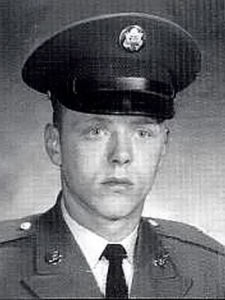
|

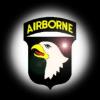

| |
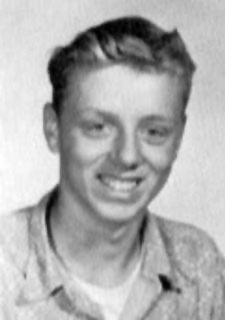
SP5 DAVID ALAN STIYER
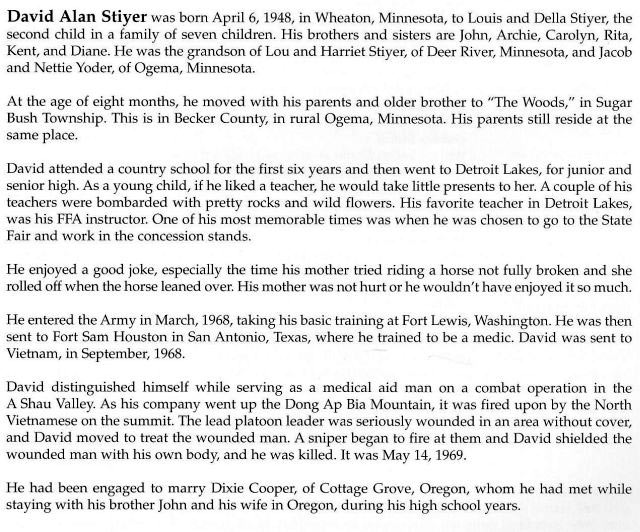
SP5 DAVID ALAN STIYER
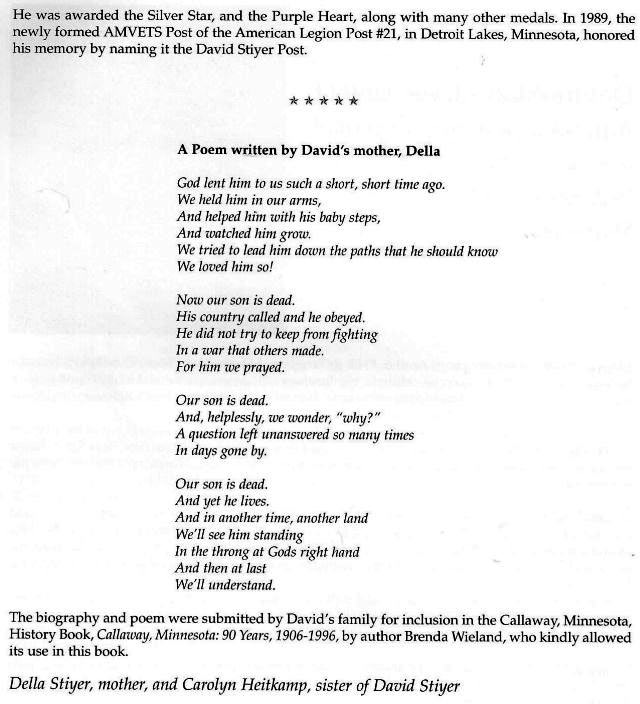
SP5 DAVID ALAN STIYER
|
|
David was one of four from my home area who made the ultimate sacrifice during the Vietnam War. The others were Don Baker, Errol Kent, along with David from Ogema and Bob Rassel from Waubun. I did not know David but my wife was a classmate and she always spoke very highly of him. After my own tour of duty in Vietnam I went on to become a career high school teacher. As a reminder to myself, and others, I created a tribute wall in the corner of my classroom dedicated to David, Don, Bob and Errol. I created it as a reminder as to how lucky and blessed I was to survive the Vietnam experience and to go on and have a successful teaching career. My wall included "rubbings" from both the National and Minnesota Vietnam Memorials as well as from the Moving Wall when it was in our area. In addition I added to it information I would find about them on the Internet. Over the years many, many students would ask me who these people were, how I knew them and what they were like. My answer was always: "Four of the finest people God ever placed on this earth!" Time eases the pain, memories come and go, but the loss is forever. David, Don, Bob and Errol - you are not forgotten.
Terry Teiken |
A Note from The Virtual WallDuring the Tet Offensive of 1968 the NVA had staged an entire NVA division and other VC forces through the A Shau Valley for its massive attacks on Hue and Da Nang. Although Tet '68 turned out to be a military disaster (but a political victory) for the NVA and VC, by early 1969 it was becoming apparent that A Shau Valley was once again an area of high NVA activity, logistically and strategically, and an important terminus for the Ho Chi Minh Trail.In May of 1969 the American command planned to clear out the A Shau Valley using ten battalions of infantry, including the 9th Marine Regiment, the 3d ARVN Regiment, the 3/5th Cavalry, and three air assault battalions: 1/506th, 2/501st, and 3/187th. The overall plan of attack called for the Marines and the 3/5th Cavalry to combat-assault into the valley and move toward the Laotian border while the ARVN units cut the highway through the base of the valley. The 2/501st and the 1/506th were to destroy the enemy in their own operating areas and block escape routes into Laos. The "Rakkasans" of the 3rd Battalion, 187th Infantry, drew what turned out to be the toughest part of the operation: Clear and occupy Dong Ap Bia, a mountain that rose to 970 meters at its highest point with ridgelines at 800, 900, 916, and 937 meters high. The terrain in the area favored the defenders. The mountains they were to defend and their ridges were along the Trung Pham River on the Laotian border. The area was covered with a tropical, double- and triple-canopied jungle. The land beneath the trees was a tangled mass of saw-toothed elephant grass, thick stands of bamboo, and other foliage that inhibited foot movement, even without an enemy presence. The hills gave way to ridgelines, cut with deep ravines, saddles, draws, and smaller hills. It was an area long occupied by the NVA and fortified with bunkers, spider holes, deep tunnels, trenches, and underground shelters for aid stations, command posts, and storage depots. And this time the NVA intended to stand their ground. Operations began on 10 May 1969 when the lead companies of 1/506th and 3/187th Infantry were inserted by air and began movements toward their assigned objectives. Although the initial landings were not opposed, by mid-afternoon Bravo 3/187 was in contact. 3/187 went into a night defensive position at dusk on 10 May and continued movement toward Dong Ap Bia's peaks at daybreak on 11 May. Contact increased during the day, and captured documents indicated the 29th NVA Regiment, with a strength of between twelve and eighteen hundred men, was defending the hill complex. Heavy fighting continued for the next 11 days as the soldiers, Marines, and ARVN troops fought their way through the hills and jungles. When it ended, the NVA/VC forces had been pushed across the border after taking heavy losses - but so too did the Allied forces. On 14 May the 3rd Bn, 187th Infantry lost 9 men on the slopes of Dong Ap Bia - a mountain which became known as "Hamburger Hill":
Medics on the Wall memorial which honors the Army Medics and Navy Corpsmen who died in Vietnam. |
| Contact Us | © Copyright 1997-2019 www.VirtualWall.org, Ltd ®(TM) | Last update 08/15/2019. |